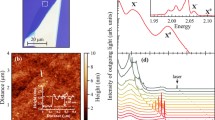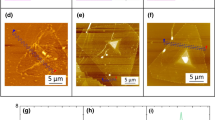Abstract
The polarization selection rule of Raman scattering is crucial in symmetry analysis of elementary excitations in semiconductors and correlated electron systems. Here we reported the observation of breakdown of Raman selection rules in few-layer WS2 by using resonant Raman spectroscopy. When the excitation energy is close to the dark A exciton state, we observed some infrared active modes and backscattering forbidden modes. Importantly, we found that all observed phonon modes follow the same paralleled-polarization behavior. According to the electron-phonon coupling near the band edge in WS2, we proposed a theoretical model based on the intraband Fröhlich interaction. In this case, the polarization response of the scattering signal is no longer determined by the original Raman tensor of scattered phonons. Instead, it is determined by a new isotropic Raman tensor that generated from this intraband Fröhlich interaction between dark A exciton and phonons. We found that this theoretical model is in excellent agreement with the observed results. The breakdown of Raman selection rules can violate the conventional limitations of the optical response and provide an effective method to control the polarization of Raman scattering signals in two-dimensional materials.

Similar content being viewed by others
References
Loudon, R. The Raman effect in crystals. Adv. Phys. 1964, 13, 423–482.
Huang, K.; Rhys, A. Theory of light absorption and non-radiative transitions in F-centres. Proc. Roy. Soc. A Mathem., Phys. Eng. Sci. 1950, 204, 406–423.
Zhang, Q.; Zhang, J.; Utama, M. I. B.; Peng, B.; de la Mata, M.; Arbiol, J.; Xiong, Q. H. Exciton-phonon coupling in individual ZnTe nanorods studied by resonant Raman spectroscopy. Phys. Rev. B 2012, 85, 085418.
Henry, C. H.; Hopfield, J. J. Raman scattering by polaritons. Phys. Rev. Lett. 1965, 15, 964–966.
Sanvitto, D.; Kéna-Cohen, S. The road towards polaritonic devices. Nat. Mater. 2016, 15, 1061–1073.
Cooper, S. L.; Slakey, F.; Klein, M. V.; Rice, J. P.; Bukowski, E. D.; Ginsberg, D. M. Gap anisotropy and phonon self-energy effects in single-crystal YBa2Cu3O7-δ. Phys. Rev. B 1988, 38, 11934–11937.
Devereaux, T. P.; Häckl, R. Inelastic light scattering from correlated electrons. Rev. Mod. Phys. 2007, 79, 175–233.
Shen, X. Q.; Choi, H.; Chen, D. Y.; Zhao, W.; Armani, A. M. Raman laser from an optical resonator with a grafted single-molecule monolayer. Nat. Photonics 2019, 14, 95–101.
Ayars, E.; Hallen, H. Electric field gradient effects in NSOM-Raman spectroscopy. In Proceedings of American Physical Society, Annual March Meeting, Washington, 2001, pp. U96–U96.
Ismail, N.; El-Meligi, A. A.; Temerk, Y. M.; Madian, M. Synthesis and characterization of layered FePS3 for hydrogen uptake. Int. J. Hyd. Energy 2010, 35, 7827–7834.
Kneipp, K.; Jorio, A.; Kneipp, H.; Brown, S. D. M.; Shafer, K.; Motz, J.; Saito, R.; Dresselhaus, G.; Dresselhaus, M. S. Polarization effects in surface-enhanced resonant Raman scattering of single-wall carbon nanotubes on colloidal silver clusters. Phys. Rev. B 2001, 63, 081401.
Takase, M.; Ajiki, H.; Mizumoto, Y.; Komeda, K.; Nara, M.; Nabika, H.; Yasuda, S.; Ishihara, H.; Murakoshi, K. Selection-rule breakdown in plasmon-induced electronic excitation of an isolated single-walled carbon nanotube. Nat. Photonics 2013, 7, 550–554.
Yu, P. Y.; Shen, Y. R.; Petroff, Y.; Falicov, L. M. Resonance Raman scattering at the forbidden yellow exciton in Cu2O. Phys. Rev. Lett. 1973, 30, 283–286.
Cardona, M. Light Scattering in Solids I: Introductory Concepts; Springer: Berlin, Heidelberg, 1983.
Liu, X. L.; Hersam, M. C. 2D materials for quantum information science. Nat. Rev. Mater. 2019, 4, 669–684.
Liu, Y.; Weiss, N. O.; Duan, X. D.; Cheng, H. C.; Huang, Y.; Duan, X. F. van der Waals heterostructures and devices. Nat. Rev. Mater. 2016, 1, 16042.
Zeng, H. L.; Cui, X. D. An optical spectroscopic study on two-dimensional group-VI transition metal dichalcogenides. Chem. Soc. Rev. 2015, 44, 2629–2642.
Wang, G.; Chernikov, A.; Glazov, M. M.; Heinz, T. F.; Marie, X.; Amand, T.; Urbaszek, B. Colloquium: Excitons in atomically thin transition metal dichalcogenides. Rev. Mod. Phys. 2018, 90, 021001.
Dery, H.; Song, Y. Polarization analysis of excitons in monolayer and bilayer transition-metal dichalcogenides. Phys. Rev. B 2015, 92, 125431.
Echeverry, J. P.; Urbaszek, B.; Amand, T.; Marie, X.; Gerber, I. C. Splitting between bright and dark excitons in transition metal dichalcogenide monolayers. Phys. Rev. B 2016, 93, 121107.
Scheuschner, N.; Gillen, R.; Staiger, M.; Maultzsch, J. Interlayer resonant Raman modes in few-layer MoS2. Phys. Rev. B 2015, 91, 235409.
del Corro, E.; Botello-Méndez, A.; Gillet, Y.; Elias, A. L.; Terrones, H.; Feng, S.; Fantini, C.; Rhodes, D.; Pradhan, N.; Balicas, L. et al. Atypical exciton-phonon interactions in WS2 and WSe2 monolayers revealed by resonance Raman spectroscopy. Nano Lett. 2016, 16, 2363–2368.
Song, Q. J.; Tan, Q. H.; Zhang, X.; Wu, J. B.; Sheng, B. W.; Wan, Y.; Wang, X. Q.; Dai, L.; Tan, P. H. Physical origin of Davydov splitting and resonant Raman spectroscopy of Davydov components in multilayer MoTe2. Phys. Rev. B 2016, 93, 115409.
Lin, M. L.; Zhou, Y.; Wu, J. B.; Cong, X.; Liu, X. L.; Zhang, J.; Li, H.; Yao, W.; Tan, P. H. Cross-dimensional electron-phonon coupling in van der Waals heterostructures. Nat. Commun. 2019, 10, 2419.
Tan, Q. H.; Sun, Y. J.; Liu, X. L.; Zhao, Y. Y.; Xiong, Q. H.; Tan, P. H.; Zhang, J. Observation of forbidden phonons, Fano resonance and dark excitons by resonance Raman scattering in few-layer WS2. 2D Mater. 2017, 4, 031007.
Miller, B.; Lindlau, J.; Bommert, M.; Neumann, A.; Yamaguchi, H.; Holleitner, A.; Högele, A.; Wurstbauer, U. Tuning the Fröhlich exciton-phonon scattering in monolayer MoS2. Nat. Commun. 2019, 10, 807.
Liang, L. B.; Zhang, J.; Sumpter, B. G.; Tan, Q. H.; Tan, P. H.; Meunier, V. Low-frequency shear and layer-breathing modes in Raman scattering of two-dimensional materials. ACS Nano 2017, 11, 11777–11802.
Zhang, X.; Han, W. P.; Wu, J. B.; Milana, S.; Lu, Y.; Li, Q. Q.; Ferrari, A. C.; Tan, P. H. Raman spectroscopy of shear and layer breathing modes in multilayer MoS2. Phys. Rev. B 2013, 87, 115413.
Kim, J.; Lee, J. U.; Lee, J.; Park, H. J.; Lee, Z.; Lee, C.; Cheong, H. Anomalous polarization dependence of Raman scattering and crystallographic orientation of black phosphorus. Nanoscale 2015, 7, 18708–18715.
Ling, X.; Huang, S. X.; Hasdeo, E. H.; Liang, L. B.; Parkin, W. M.; Tatsumi, Y.; Nugraha, A. R. T.; Puretzky, A. A.; Masih Das, P.; Sumpter, B. G. et al. Anisotropic electron-photon and electronphonon interactions in black phosphorus. Nano Lett. 2016, 16, 2260–2267.
Qiao, X. F.; Wu, J. B.; Zhou, L. W.; Qiao, J. S.; Shi, W.; Chen, T.; Zhang, X.; Zhang, J.; Ji, W.; Tan, P. H. Polytypism and unexpected strong interlayer coupling in two-dimensional layered ReS2. Nanoscale 2016, 8, 8324–8332.
Chen, X. T.; Lu, X.; Dubey, S.; Yao, Q.; Liu, S.; Wang, X. Z.; Xiong, Q. H.; Zhang, L. F.; Srivastava, A. Entanglement of single-photons and chiral phonons in atomically thin WSe2. Nat. Phys. 2019, 15, 221–227.
Martin, R. M. Theory of the one-phonon resonance Raman effect. Phys. Rev. B 1971, 4, 3676–3685.
Mak, K. F.; Lee, C.; Hone, J.; Shan, J.; Heinz, T. F. Atomically thin MoS2: A new direct-gap semiconductor. Phys. Rev. Lett. 2010, 105, 136805.
Qiu, D. Y.; Da Jornada, F. H.; Louie, S. G. Optical spectrum of MoS2: Many-body effects and diversity of exciton states. Phys. Rev. Lett. 2015, 115, 216805.
Chernikov, A.; van der Zande, A. M.; Hill, H. M.; Rigosi, A. F.; Velauthapillai, A.; Hone, J.; Heinz, T. F. L. Electrical tuning of exciton binding energies in monolayer WS2. Phys. Rev. Lett. 2015, 115, 126802.
Carvalho, B. R.; Malard, L. M.; Alves, J. M.; Fantini, C.; Pimenta, M. A. Symmetry-dependent exciton-phonon coupling in 2D and bulk MoS2 observed by resonance Raman scattering. Phys. Rev. Lett. 2015, 114, 136403.
Molas, M. R.; Faugeras, C.; Slobodeniuk, A. O.; Nogajewski, K.; Bartos, M.; Basko, D. M.; Potemski, M. Brightening of dark excitons in monolayers of semiconducting transition metal dichalcogenides. 2D Mater. 2017, 4, 021003.
Zhou, Y.; Scuri, G.; Wild, D. S.; High, A. A.; Dibos, A.; Jauregui, L. A.; Shu, C.; De Greve, K.; Pistunova, K.; Joe, A. Y. et al. Probing dark excitons in atomically thin semiconductors via near-field coupling to surface plasmon polaritons. Nat. Nanotechnol. 2017, 12, 856–860.
Wang, G.; Robert, C.; Glazov, M. M.; Cadiz, F.; Courtade, E.; Amand, T.; Lagarde, D.; Taniguchi, T.; Watanabe, K.; Urbaszek, B. et al. In-plane propagation of light in transition metal dichalcogenide monolayers: Optical selection rules. Phys. Rev. Lett. 2017, 119, 047401.
Park, K. D.; Jiang, T.; Clark, G; Xu, X. D.; Raschke, M. B. Radiative control of dark excitons at room temperature by nano-optical antenna-tip purcell effect. Nat. Nanotechnol. 2017, 13, 59–64.
Shi, W.; Lin, M. L.; Tan, Q. H.; Qiao, X. F.; Zhang, J.; Tan, P. H. Raman and photoluminescence spectra of two-dimensional nano-crystallites of monolayer WS2 and WSe2. 2D Mater. 2016, 3, 025016.
Zhang, X. X.; Cao, T.; Lu, Z. G.; Lin, Y. C.; Zhang, F.; Wang, Y.; Li, Z. Q.; Hone, J. C.; Robinson, J. A.; Smirnov, D. et al. Magnetic brightening and control of dark excitons in monolayer WSe2. Nat. Nanotechnol. 2017, 12, pages883–888.
Jin, C. H.; Kim, J.; Wu, K. D.; Chen, B.; Barnard, E. S.; Suh, J.; Shi, Z. W.; Drapcho, S. G; Wu, J. Q.; Schuck, P. J. et al. On optical dipole moment and radiative recombination lifetime of excitons in WSe2. Adv. Funct. Mater. 2016, 27, 1601741.
Wang, Z. L.; Molina-Sánchez, A.; Altmann, P.; Sangalli, D.; De Fazio, D.; Soavi, G.; Sassi, U.; Bottegoni, F.; Ciccacci, F.; Finazzi, M. et al. Intravalley spin-flip relaxation dynamics in single-layer WS2. Nano Lett. 2018, 18, 6882–6891.
Robert, C.; Amand, T.; Cadiz, F.; Lagarde, D.; Courtade, E.; Manca, M.; Taniguchi, T.; Watanabe, K.; Urbaszek, B.; Marie, X. Fine structure and lifetime of dark excitons in transition metal dichalcogenide monolayers. Phys. Rev. B 2017, 96, 155423.
Martin, R. M.; Damen, T. C. Breakdown of selection rules in resonance Raman scattering. Phys. Rev. Lett. 1971, 26, 86–88.
Yu, P. Y.; Cardona, M. Fundamentals of Semiconductors: Physics and Materials Properties; 4th ed. Springer: New York, 2010.
Acknowledgements
J. Z. and P. T. acknowledge support from the National Basic Research Program of China (Nos. 2017YFA0303401 and 2016YFA0301200), Beijing Natural Science Foundation (No. JQ18014), and the Strategic Priority Research Program of the Chinese Academy of Sciences (No. XDB28000000).
Author information
Authors and Affiliations
Corresponding author
Additional information
Competing interests
The authors declare no competing financial interest.
Electronic Supplementary Material
Rights and permissions
About this article
Cite this article
Tan, QH., Sun, YJ., Liu, XL. et al. Breakdown of Raman selection rules by Fröhlich interaction in few-layer WS2. Nano Res. 14, 239–244 (2021). https://doi.org/10.1007/s12274-020-3075-3
Received:
Revised:
Accepted:
Published:
Issue Date:
DOI: https://doi.org/10.1007/s12274-020-3075-3




